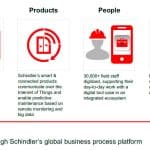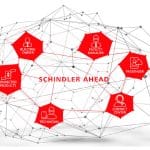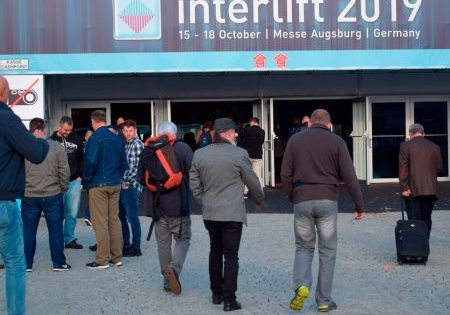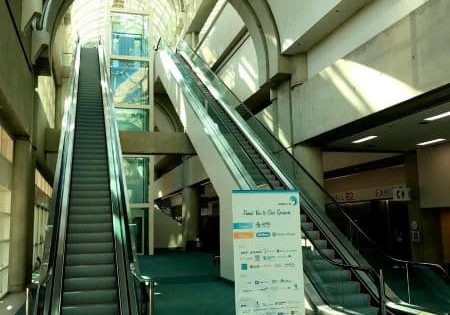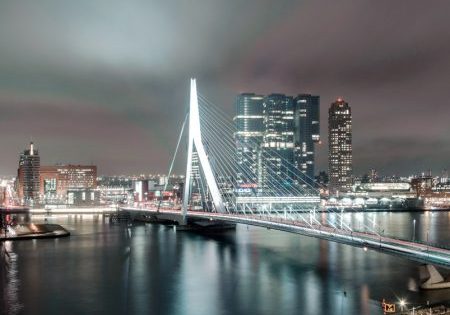Schindler AHEAD shows how cutting-edge technology can reduce downtime and increase customer satisfaction.
by Matthias Schiller and Dr. Clarissa Falge
This article was first presented at the 2018 International Elevator & Escalator Symposium in Istanbul. For more information on December 3-4, 2019’s event in Las Vegas and to participate, visit www.elevatorsymposium.org.
The Internet of Things (IoT), through which virtually all physical objects can become connected to the internet, promises enormous economic potential. The IoT is disrupting entire industries and forcing companies to rethink their current business activities. Schindler’s response is Schindler AHEAD, a digital business strategy and brand based on the “Internet of Elevators & Escalators” (IoEE) program. Data detected by smart sensors in Schindler units varies from component dynamics to energy consumption or temperature fluctuations. It is transmitted to an edge device where learning algorithms detect anomalies and send the information through the cloud to the engineering personnel. Such a connected ecosystem reduces downtime of installations, accelerates product development and increases customer satisfaction.
Potentials and Challenges of IoT and Connected Devices
The number of businesses investing in IoT technology across all markets continues to grow, and thousands of companies are realizing its transformational benefits.[1] Global research and advisory company Gartner defines IoT as “a network of dedicated physical objects (things) that contain embedded technology to sense or interact with their internal state or the external environment,” excluding general-purpose devices like smartphones, tablets and PCs.[2] For companies, IoT brings new ways to monitor and manage objects in the physical world, while massive new streams of data offer better avenues for decision-making — often mediated by machines.[1] The steady fall in prices of sensors and technologies, combined with a parallel rise in understanding their application scenarios, have boosted the strategic importance of the IoT.[3]
According to Gartner, IoT technology will be in 95% of electronics for new product designs by 2020.[4] Boston Consulting Group anticipates that, by 2020, more than 25 billion connected devices will be in use.[5] Market intelligence provider International Data Corp. recently forecasted that IoT spending will experience a compound annual growth rate of 13.6% over the 2017-2022 period and reach US$1.2 trillion in 2022.[6] Economic analysts McKinsey Global Institute estimates that, by 2025, IoT will have a potential total economic impact of as much as US$11.1 trillion per year. In fact, IoT will be the biggest source of value of all disruptive technologies, ahead of mobile internet, knowledge work automation, cloud computing and advanced robotics.[7]
There are new “digital champions” from traditional industries who have transformed their businesses into integrated digital ecosystems thanks to the tightly meshed coordination of products, technology, processes and people, and who generate sustainable, profitable growth.[8] These digital champions among the incumbents understand that digital transformation means not only optimizing the existing business with the aid of digital technologies, but also transforming the existing business model or even setting up new, complementary business areas — or, in the words of PayPal founder Peter Thiel, “Today’s ‘best practices’ lead to dead ends; the best paths are new and untried.”[9]
Schindler AHEAD
Already, a few million people use IoT-connected Schindler products each day. Digital transformation has immensely helped us further our mission to ensure the safety and reliability of that vast system. Hence, IoT is a strategic top priority for Schindler to boost growth by developing new digital business models. Launched in 2017 as a brand based on the IoEE, Schindler AHEAD provides a unique, cloud-based digital service connecting machines, users, technicians and around-the-clock call centers in a closed-loop ecosystem. Schindler will continue to invest in the smart networking of products and digital processes.[10]
The complexity of emerging IoT solutions brings complex challenges, such as a lack of protocol standardization, scalability limitations, energy supply and security issues, better utilization of IoT data and the ability to address new use cases.[11] From the security standpoint, the highly connected nature of IoT devices means they are constantly in communication, thus capable of spreading malware and of leaping from system to system with no human interaction — all beyond the reach of current security solutions.[12] Consequently, Schindler is investing heavily in cybersecurity and has initiated a dedicated program and organizational unit. All communication is encrypted using the highest security standards, and only the minimal required data is collected.[13]
IoT and the Personalization of the Customer Experience
The IoT is the connection of objects from the physical world that are equipped with sensors, actuators and communication technology.[14] The IoT describes a broader vision: that all sorts of objects become “smart,” able to gather data and communicate both with each other and the internet.[15] Porter and Heppelmann argue that the key novelty of IoT solutions lies in the changed “nature of the ‘things,’”[16] including their connectivity and the digital services they facilitate.[11] Such offerings, spanning the digital and the physical worlds, require a broad array of enabling technologies, which is reflected in various value-creation layers inherent to IoT solutions.
To implement an IoT business model, three stages can be identified: networking and automation are key elements to get connected; insights are extracted from the gathered data with the help of data science algorithms and machine-learning; and, based on the derived insights, cost efficiency can be increased or new business models discovered.
While the term “Internet of Things” draws attention to the interconnectivity of equipment, machines, gadgets and other “things” in general, at its core are the people. Innovation should always be addressed from the customer perspective.[17] What are the unfulfilled customer requirements? Innovation must cover, if not generate, a need. Disruptive innovations frequently address requirements that the potential user cannot articulate or imagine. As Henry Ford supposedly once said, “If I’d asked my customers what they wanted, they would have said a faster horse.” Therefore, successful businesses are customer-centric, placing the client at the heart of their creative processes, production operations and delivery options. Any IoT-based service aims for maximal convenience for the users, allowing people to focus on their desired areas of private or business life by minimizing the effort needed to interact with all these “things.”
The industrial market has taken the opportunities of IoT to another level and has come up with the “IoT size one” paradigm. As part of the increasing digitization of production — a trend known as Industry 4.0 — it is now possible to manufacture individual pieces based on a flexible and responsive manner of ordering. The entire process is tailored to the needs of the customer as a consequence of the overarching principle known as the “economy of one” guiding the organizations in all industries today. The “have it your way” consumer experiences have changed the way the business world thinks about sales. Even business-to- business buyers have gradually been conditioned to expect the same personalized treatment that they get while shopping on Amazon.[18] Marketing’s focus is shifting from customer loyalty to serving a customer’s most important needs at the moment. In the U.S. market alone, firms are already losing US$1 trillion in annual revenues to competitors because they are not consistently relevant enough.[19]
“Using innovative technologies such as the IoT, edge computing and advanced analytics, we can offer customers and passengers real-time data, insights, enhanced reliability and convenience,” says Michael Nilles, executive member of the Board of Directors and chief digital officer for Schindler.
Schindler’s Journey of Digitalization and Strategy
Outstanding process excellence engendered by digitalization leads to higher customer satisfaction, which impacts market share as well as opportunities for up-selling and cross-selling. The most disruptive effect of IoT, however, is the innovation of business models. IoT deployment often leads to disruptive innovation, because network effects facilitate the rapid scaling of solutions and market penetrations.[1] It is important to consider the entire ecosystem and not simply your own value chain.[20] The question is no longer if the next Uber will take over my industry, but when. So, for digital disruption, the key is to match the agility of small firms and new entrants, while leveraging the experience and scale of being an established market player. This is the entrepreneurial spirit fostered in Schindler’s IoEE program by the recently founded Schindler Digital Group, AG.
The four cornerstones of Schindler’s digital strategy are (Figure 1[21 & 22]):
- Customers
- Products
- People
- Processes
As Figure 2 depicts, Schindler’s digitalization journey followed three strategic themes:
- Information technology rationalization
- Operational excellence
- Leading-edge digital business
Schindler AHEAD Digital Services Ecosystem
The rise of IoT is one reason why computing is emerging from the centralized cloud and moving to an “edge” of networks and intelligent devices. Schindler AHEAD is the industry’s first digital closed-loop platform that connects the equipment, customers and passengers with Schindler’s Contact Centers and technicians (Figure 3).
Startups and incumbents alike are rushing into the market for edge-computing services, which is expected to grow to US$6.7 billion by 2022.[23] By 2021, 40% of enterprises will have an edge computing strategy in place, up from about 1% in 2017, according to Gartner.
As Figure 4 depicts, once the elevator and escalator are equipped with Schindler’s Cube, an edge-computing device, customers can avail the benefits from predictive maintenance, real-time facts and new avenues of monetization. The Cube is a smart communications hub with edge computing power on board, where machine learning algorithms integrated into the hardware detect anomalies. Data gets preanalyzed before it is sent to the cloud to keep data transmission to a minimum and speed up data analytics or make quick decisions if necessary. There are certain cases in which real-time machine intelligence is needed.
The AHEAD Cloud Platform is the engine for big-data analytics and artificial intelligence. In combination with General Electric’s leading Predix solution, we gain powerful insights through advanced analytics and machine learning. If the edge- computing algorithm detects that a component is about to fail, it will trigger a notification to be sent over the cloud to a maintenance worker, so the problem is identified and fixed days before failure occurs. Over-the-air updates ensure that the Cube never gets outdated, and it is able to unleash new services instantly through a growing portfolio of Cube apps.
Summary and Success Factors of Schindler’s IoEE Program
Schindler’s award-winning accomplishments concerning its digital strategy were reported by Apple in a “Customer Success Story”[24] and have generally been well-received in the market.[25 & 26] Schindler strongly believes in the innovation potential of digital technologies for new and disruptive business models, and that an enterprise needs to critically analyze its business model before someone else does.
The well-known “inadequacies” of existing products and services are a key indicator of innovation potentials, irrespective of whether these relate to the purchase and use experience, cost-benefit ratio, or availability.[27 & 28] An excellent example for this is the growth domain of “smart and connected products,” which Schindler pursues with its AHEAD Services. With these products’ valuable information at our fingertips, preventive and predictive action can be taken faster — improving the overall decision-making, performance and uptime.
Schindler IoEE proves that simply connecting a “thing” to the internet isn’t enough — you must be able to ensure that the data generated by that thing can be leveraged to enable new business benefits. However, no one is able to predict which combination of technology and business model has what it takes to radically transform a market or create a new one. Figures from Silicon Valley show that 70-90% of all startups fail, and only a tiny percentage lead to the genuinely disruptive transformation of an industry. Therefore, successful investors pursue a large number of sometimes competing innovation ideas, either alone or with partners, and push initially unsuccessful ideas back onto the market following recombination and iteration.[29] To take full advantage of new digital technologies, you need to take a holistic approach, as Schindler has via its global IoEE program.[30]
Finally, as Maciej Kranz notes, the promise of IoT as the basis for digital transformation is:
“. . . supercharging business to better serve customers and stakeholders. But, to fully realize IoT’s potential, companies need to approach it as a multifaceted journey, making changes to their business models and strategies — or risk ending their trip before it really begins.”[31]
- Figure 1: Cornerstones of the digital strategy at Schindler
- Figure 2: Schindler’s digitalization journey
- Figure 3: Schindler AHEAD Digital Services Ecosystem
- Figure 4: Creating the IoEE
References
[1] S. Turber, J. Vom Brocke, O. Gassmann, and E. Fleisch, “Designing Business Models in the Era of Internet of Things: Towards a Reference Framework,” Lect. Notes Comput. Sci. (including Subser. Lect. Notes Artif. Intell. Lect. Notes Bioinformatics), Vol. 8463 LNCS, p. 17–31, 2014.
[2] S. Ganguli and T. Friedman, “IoT Technology Disruptions: A Gartner Trend Insight Report What You Need to Know,” Gartner, June,
p. 1–12, 2017.
[3] B.M. Chui, B. May, and S. Narayanan, “What It Takes to Get an Edge in the Internet of Things,” McKinsey Global Institute, 2018.
[4] K. Panetta, “Gartner Top Strategic Predictions for 2018 and Beyond,” Gartner, p. 1, 2017.
[5] BCG, “How to Adopt and Monetize IoT Technology,” 2018. [Online]. Available: www.bcg.com/en-ch/digital-bcg/internet-of-things.aspx.
[6] IDC, “Worldwide Semiannual Internet of Things Spending Guide,” p. 4–5, 2017.
[7] J. Manyika et al., “The Internet of Things: Mapping the Value Beyond the Hype,” McKinsey Glob. Inst., June, p. 144, 2015.
[8] G.P. Pisano, “You Need An Innovation Strategy,” Harv. Bus. Rev., Vol. 93, No. 6, p. 44–54, 2015.
[9] P. Thiel and B. Masters, “Zero to One: Notes on Startups, or How to Build the Future,” Crown Business, 2014.
[10] Schindler, “Annual Report 2017 — Group Review,” 2018.
[11] D. Bilgeri and F. Wortmann, “Barriers to IoT Business Model Innovation,” Wirtschaftsinformatik, No. 2, p. 1–22, 2017.
[12] Y. Dibrov, “The Internet of Things Is Going to Change Everything About Cybersecurity,” Harv. Bus. Rev., p. 1–6, 2017.
[13] S. Gupta and M. Schneider, “Protecting Customers’ Privacy Requires More than Anonymizing Their Data,” Harv. Bus. Rev., June,
p. 1–4, 2018.
[14] R.M. Dijkman, B. Sprenkels, T. Peeters, and A. Janssen, “Business Models for the Internet of Things,” Int. J. Inf. Manage., 2015.
[15] E. Fleisch, M. Weinberger, and F. Wortmann, “Geschäftsmodelle im Internet der Dinge,”
HMD Prax. der Wirtschaftsinformatik, 2014.
[16] M.E. Porter and J.E. Heppelmann, “How Smart, Connected Products Are Transforming Competition,” Harv. Bus. Rev., 2014.
[17] H. Österle and E. Senger, “Prozessgestaltung und IT: Von der Unternehmens- zur Konsumentensicht,” Control. Manag., Vol. 55, p. 80–88, 2011.
[18] J. Shriber, “How B2B Sellers Are Offering Personalization at Scale,” Harv. Bus. Rev., July, 2018.
[19] J. Zealley, R. Wollan, and J. Bellin, “Marketers Need to Stop Focusing on Loyalty and Start Thinking About Relevance,” Harv. Bus. Rev., March, 2018.
[20] D. Bonnet, J. Buvat, and K. Subrahmanyam, “When Digital Disruption Strikes: How Can Incumbents Respond? Volatility and Corporate Darwinism,” Capgemini Consult., 2015.
[21] M. Nilles, “Mehr Disruption wagen,” Enkelfähig, No. 11, Nov. 2015.
[22] M.K. Pratt, “CIO is Pushing the Right Buttons,” CIO Magazine, No. 11, Nov-2015.
[23] Marketsandmarkets, “Edge Computing Market Worth 6.72 Billion USD by 2022,” 2018.
[24] Apple Inc., “Schindler — Schindler Technicians Use iPhone to Keep More Than a Billion People Moving Safely And Reliably Each Day,” 2015. [Online]. Available: www.apple.com/lae/business/success- stories.
[25] H. Haake, “Schindler Group mit Digital Business Innovation Award 2015 ausgezeichnet,” Handelsblatt, Jan. 2015.
[26] MIT Sloan CIO Symposium, “Schindler Wins MIT Sloan CIO Leadership Award 2015,” May, 2015.
[27] D. Nylén and J. Holmström, “Digital Innovation Strategy: A Framework for Diagnosing and Improving Digital Product and Service Innovation,” Bus. Horiz., Vol. 58, No. 1, p. 57–67, 2015.
[28] D. Edelman, N. Marston, and P. Willmott, “How to Scale Your Own Digital Disruption,” McKinsey & Company, Oct. 2015.
[29] G. Westerman, D. Bonnet, and A. McAfee, “Leading Digital: Turning Technology into Business Transformation.” Harvard Business Press, 2014.
[30] T.H. Davenport and G. Westerman, “Why So Many High-Profile Digital Transformations Fail,” Harv. Bus. Rev., 2018.
[31] M. Kranz, “Success with the Internet of Things Requires More Than Chasing the Cool Factor,” Harv. Bus. Rev., 2018.
Get more of Elevator World. Sign up for our free e-newsletter.
